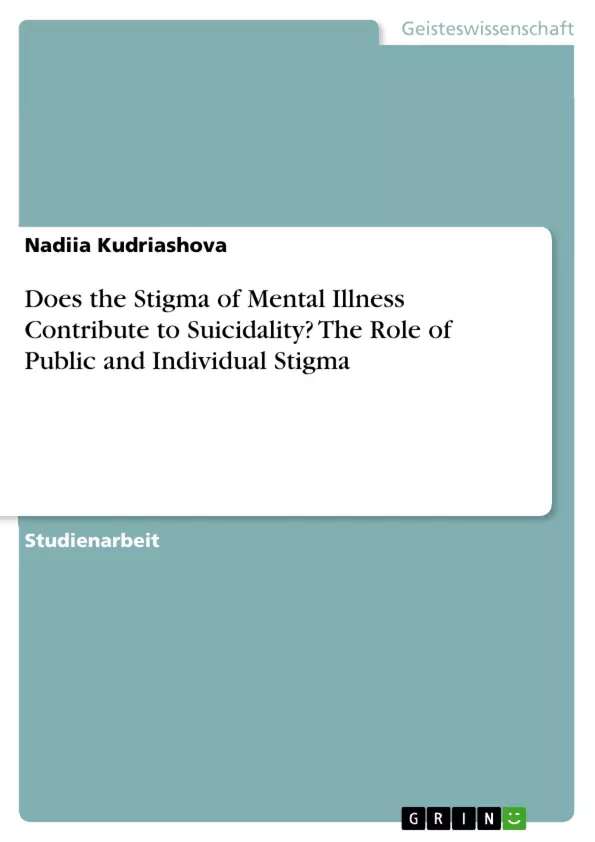The stigma of mental disorders and discrimination against the mentally ill remain the most persistent obstacle to improving the quality of life of these people. Often, a mental illness is perceived as something frightening, shameful, unreal, contrived, and incurable; mentally ill people are characterized as dangerous, unpredictable, unreliable, unstable, lazy, weak, useless and/or helpless. According to research data, the main problem is that many people with mental disorders are systematically discriminated in most areas of their lives. These forms of social exclusion occur in the family, at work, in private life, and in public activities, in the health and the media, which leads to the formation of a feeling of extreme insecurity, rejection and despair in mental patients and, accordingly, determines the high level of suicide in this categories of the population. This acute problem determines the need to study the root sources of this phenomenon, its social background, the ways to combat this phenomenon (disgraceful for a society of the 21st century), and find ways to improve the situation.
Inhaltsverzeichnis
- Introduction
- Prerequisites of mental illness stigmatization in the society
- Social mechanism of mental illness stigmatization
- The social basis of stigma
- Scientific approaches to the stigmatization of mental illnesses
- Sociological data on mental illness stigmatization
- Phenomenology of stigmatization process
- Family stigmatization
- Concepts, policies, and obstacles for the development of psycho- and socio-therapeutic measures for the de-stigmatization of mental patients
- Recommendations on general principles of work to mitigate stigmatizing attitudes
Zielsetzung und Themenschwerpunkte
Der Text befasst sich mit der Stigmatisierung psychisch Kranker und analysiert die Auswirkungen dieser Stigmatisierung auf die Lebensqualität und die Behandlungserfolge. Er beleuchtet die Ursachen und Mechanismen der Stigmatisierung, untersucht die wissenschaftlichen und soziologischen Erkenntnisse zu diesem Thema und beleuchtet die Rolle der Familie in der Stigmatisierung. Darüber hinaus werden Strategien zur Destigmatisierung und die Entwicklung von psycho- und soziotherapeutischen Maßnahmen zur Verbesserung der Situation psychisch Kranker diskutiert.
- Die Folgen der Stigmatisierung für psychisch Kranke
- Die Ursachen und Mechanismen der Stigmatisierung
- Wissenschaftliche und soziologische Erkenntnisse zur Stigmatisierung
- Die Rolle der Familie in der Stigmatisierung
- Strategien zur Destigmatisierung und Entwicklung von psycho- und soziotherapeutischen Maßnahmen
Zusammenfassung der Kapitel
Introduction
Die Einleitung definiert das Thema Stigmatisierung und ihre Auswirkungen auf psychisch Kranke. Sie erläutert die sozialen Folgen von Stigmatisierung und die Bedeutung der Destigmatisierung für die Behandlung und Rehabilitation. Es wird darauf hingewiesen, dass die Stigmatisierung in verschiedenen Ländern unterschiedlich ausgeprägt ist und dass die Überwindung dieser Stigmatisierung ein zentrales Ziel der WHO Mental Health Programms ist.
Prerequisites of mental illness stigmatization in the society
Dieser Abschnitt analysiert die Voraussetzungen für die Stigmatisierung psychisch Kranker im Kontext der modernen Psychiatrie. Er beleuchtet den Wandel in der psychiatrischen Behandlung und die Herausforderungen der Integration psychisch Kranker in die Gesellschaft.
Social mechanism of mental illness stigmatization
Dieser Abschnitt untersucht die Mechanismen der Stigmatisierung von psychisch Kranken. Die Rolle von Vorurteilen und Stereotypen wird beleuchtet und die negative soziale Distanz zu psychisch Kranken erklärt. Die Entstehung von Stigmatisierung als Reaktion auf die potenzielle Gefahr, die von psychisch Kranken ausgehen kann, wird diskutiert.
The social basis of stigma
Dieser Abschnitt analysiert die sozialen Grundlagen der Stigmatisierung. Die negative Unterscheidung von Individuen oder sozialen Gruppen aufgrund von Vorurteilen und die daraus resultierenden Reaktionen der Gesellschaft werden untersucht.
Schlüsselwörter
Die wichtigsten Schlüsselwörter und Fokusthemen des Textes sind Stigmatisierung, psychische Krankheit, soziale Distanz, Vorurteile, Stereotype, Destigmatisierung, psycho- und soziotherapeutische Maßnahmen, Familie, Gesellschaft, WHO Mental Health Programm.
- Citar trabajo
- Nadiia Kudriashova (Autor), 2019, Does the Stigma of Mental Illness Contribute to Suicidality? The Role of Public and Individual Stigma, Múnich, GRIN Verlag, https://www.grin.com/document/484384



